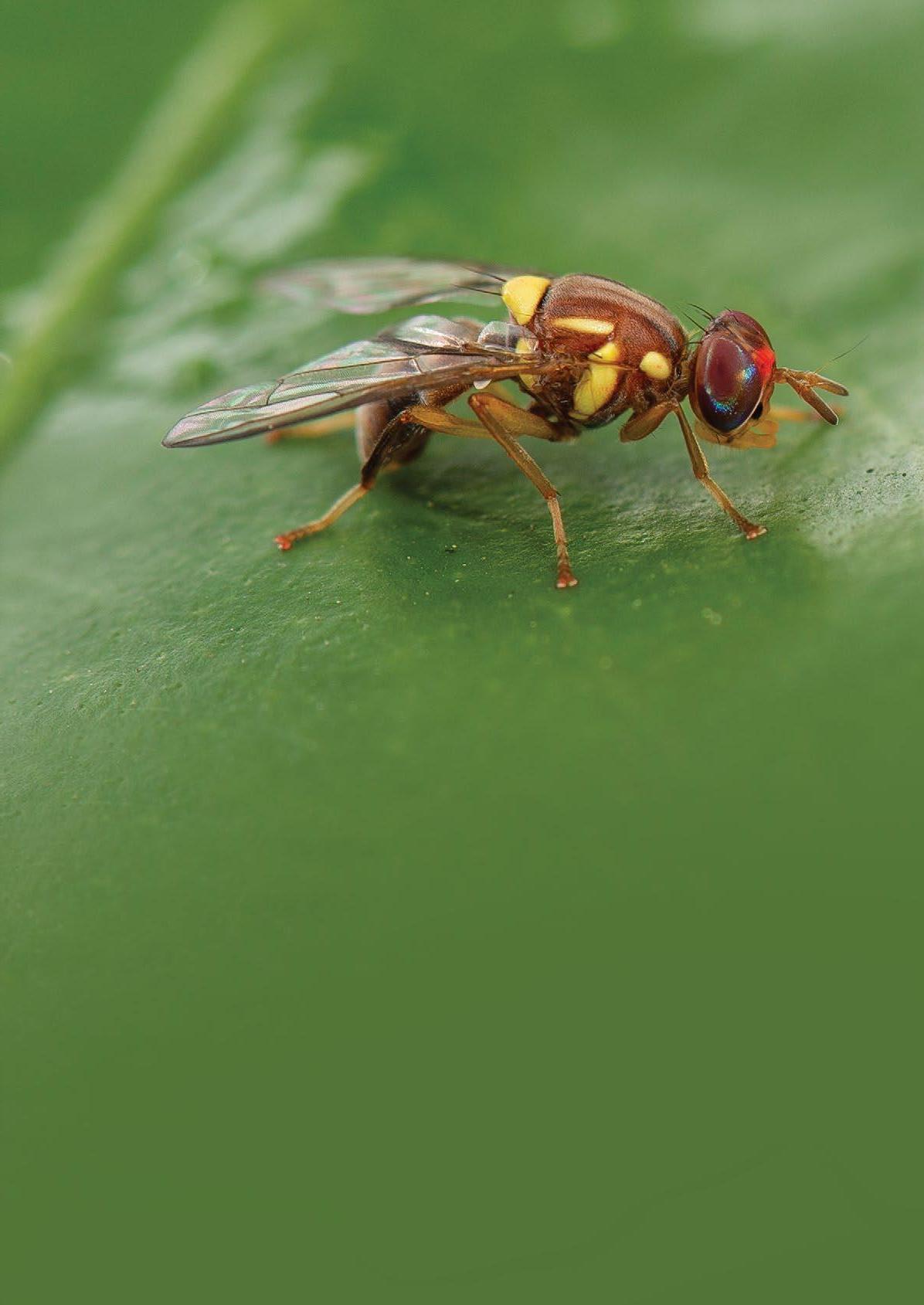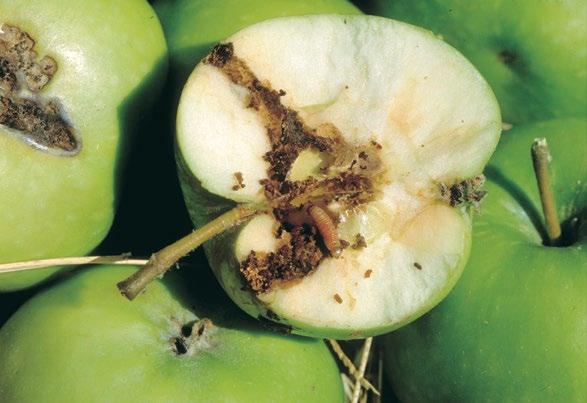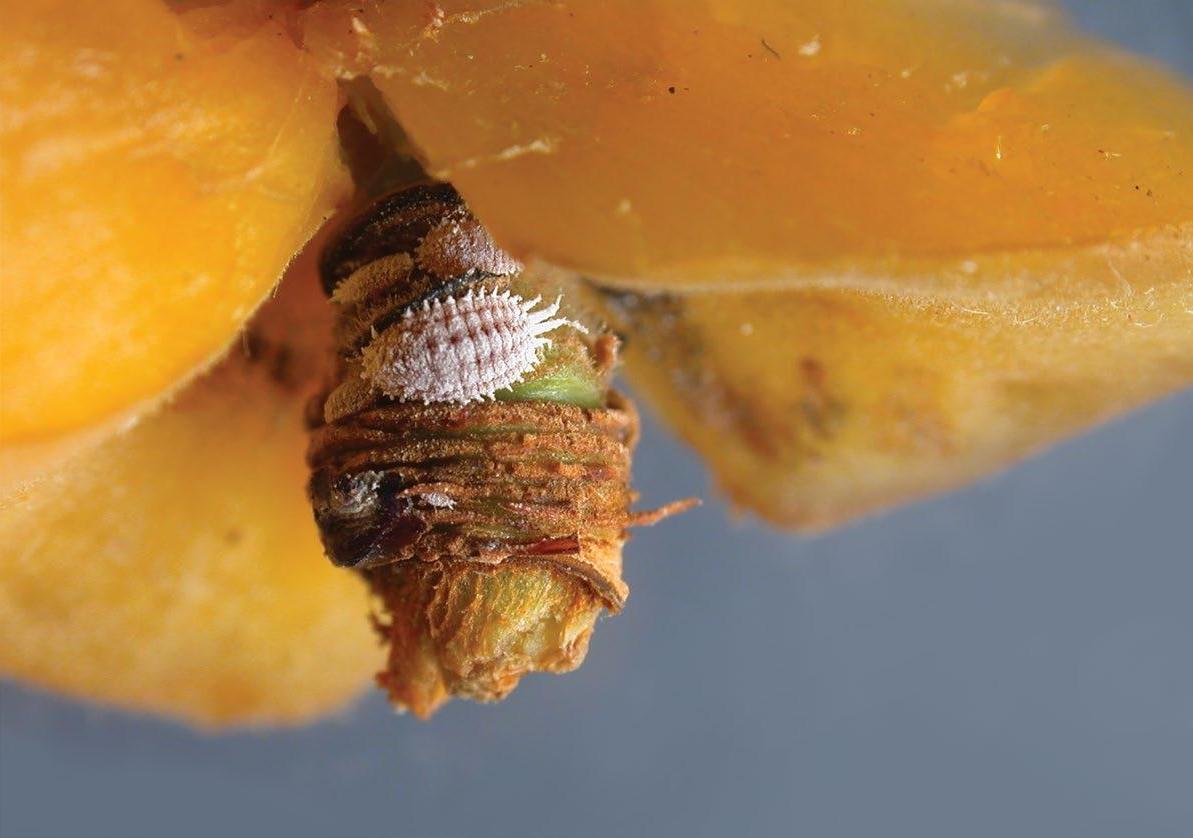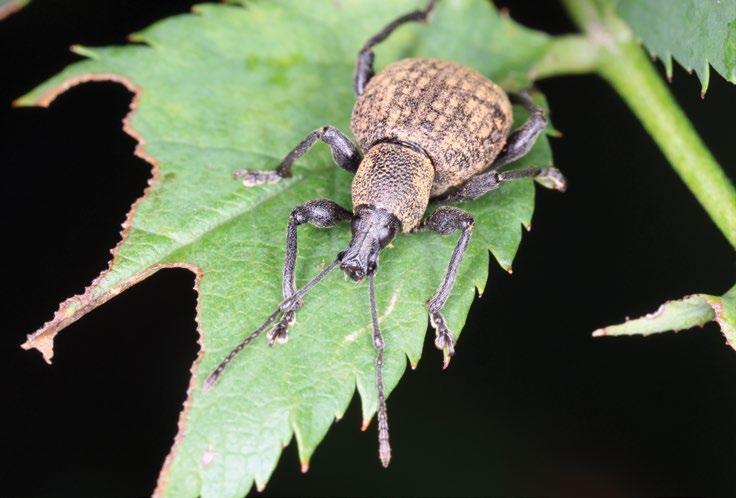
7 minute read
Pome pests
Pome pests we don’t have in WA, but are established in other Australian States
PHOTOS © DPIRD BY SUSIE MURPHY WHITE PROJECT MANAGER, POMEWEST
Advertisement
f QUEENSLAND fruit fly.
There are a number plant pests and disease of quarantine concern for the West Australian pome fruit industry that are present in other Australian states and are absent in WA at present (see Table 1). They are listed as prohibited organisms for Western Australia under section 12 of the Biosecurity and Agriculture Management Act, 2007. It is extremely important to keep our West Australian industry free of these pests and diseases to protect our industry.
Specific surveys for early detection have been occurring for codling moth and Queensland fruit fly over many decades. While other pests are part of the day-to-day surveillance activities of industry, government and the community.
DPIRD’s MyPestGuide app facilitates industry and community into reporting unusual pests that are identified and mapped.
The pests and diseases listed have the potential to cause serious crop losses to the pome industry in WA. By using early detection and reporting systems we can protect our pome industry. If you see something unusual report it immeditaely to the Pest and Disease Information Service either by phone or through the MyPestGuide Reporter app on your phone.
TABLE 1. KEY POME PESTS AND DISEASES ESTABLISHED IN AUSTRALIA BUT NOT PRESENT IN WA.
Common name
Black vine beetle Citrophilus mealybug Codling moth Oriental fruit moth Oystershell scale Pear leaf blister mite Painted apple moth Queensland fruit fly White peach scale Scientific name
Coleopteria: Curculionidqe Pseudococcus calceolarie Cydia pomonella Grapholita (Aspila) molesta Diaspidiotus ostreaeformis Epitrimerus pyri Orgyia anartoides Bactocera tryoni Pseudaulacaspis pentagona

f CODLING moth larvae f CODLING moth adult


Queensland fruit fly
Bactrocera tryoni (fly) Queensland fruit fly (Qfly) is endemic to the Northern Territory, Queensland, parts of NSW and north east Victoria. Female fruit flies follow the scent of ripening fruit and lay their eggs. Female fruit flies can lay 500–800 eggs during their 6-month life. When the ovipositor is inserted in the fruit it results in a distinctive sting on the fruit surface. In warm weather eggs hatch in 2–4 days. Maggots take 6–8 days to develop. Infested fruit often drop to the
ground. Mature maggots chew their way out of the fruit and burrow into the soil. The larva becomes inactive in the soil and develops into an oval brown pupa from which the The larvae of codling month damage fruit by tunnelling intothe fruit. adult fly develops. Codling moth Cydia pomonella (moth) Codling moth (Cydia pomonella) is a serious pest of apples and other pome fruit and has the potential to cause severe crop losses. This is the most significant pest of apples in the Eastern States of Australia. The damage is caused by the larvae which tunnel
f CODLING moth infested Granny Smith apples.
into fruit. During winter, mature larvae enter diapause in rough silken cocoons in sheltered sites near where they emerged from the fruit. Pupation and adult emergence occurs in spring. After mating, female moths lay eggs singly on leaves near developing fruit. The eggs take three to 15 days to hatch. The newly-emerged larvae move to the fruit and tunnel into the apple. The larva feeds on the flesh and seeds. Development takes 15–30 days inside the fruit.
f CITROPHILUS mealybug.

f PEAR leaf blister mite or Eriophyes pyri on pear leaf.


f INJURY caused by the larval stage of the black vine beetle feeding on the roots, is highly destructive to plants.
Painted apple moth
Teia anaretoides (moth) Painted Apple Moth is native to southeastern Australia (from southern Queensland to Victoria), S-E South Australia and Tasmania where it is a common pest on urban garden plants. It is generally relatively rare. PAM has a wide range of hosts in Australia but especially wattle (Acacia) species. Other common hosts are in the Myrtaceae, Fabaceae, Santalaceae and Solanaceae. Numerous introduced and cultivated plants are also attacked, such as pome fruit and a number of ornamental plants. varieties seem more tolerant of rust mite damage. The pear rust mite also feeds on young leaves which, if heavily attacked, turn bronze in colour. Heavy feeding can cause defoliation and reduced shoot growth. Although pear rust mite may persist on both fruit and foliage throughout the season, it causes the most severe damage in the early spring.
Oriental fruit moth
Citrophilus mealybug
Cydia molesta Busck (moth) The oriental fruit moth has been a serious pest in canning peach orchards of the Goulburn Valley in Victoria since the early 1930s, and now also infests Pseudococcus calceolaria (insect) Nashi and some other pome fruit. Citrophilus mealybug is an exotic pest The larva or caterpillar of the moth to Western Australia. It is a serious bores into the tip growth of quinces, pest of many horticultural peaches, nectarines, apricots, plums, and, occasionally, into some other fruits such as apples and pears. Later generations bore into the fruit as well. Four to six generations of oriental fruit moth occur each year in the Goulburn Valley, with varying proportions of the last three generations entering the overwintering state to give rise to the emergence of adults in the following spring. industries that can downgrade fruit quality and affect fruit production. Citrophilus mealybug extract plant sap, reducing tree vigour and production, and secrete large amounts of honeydew — an exudate high in sugar that encourages development of sooty mould. Mealybugs are soft, oval, flat, distinctly segmented, and covered with a white, mealy wax that extends into spines (filaments) along the body margin and the posterior end. These pests and diseases have the potential to cause serious crop losses to the pome industry in WA.
Pear leaf blister mite
Epitrimerus pyri (mite) Pear rust mite was probably brought to the United States from Europe in the 19th century with trees or scion cuttings. It is a common pest throughout the Pacific Northwest and can cause serious fruit damage if untreated. While several predators feed on the pear rust mite, none controls it well enough to prevent commercial damage. As pear rust mite starts feeding within the developing fruit clusters, it can damage fruit very early in the season. The feeding causes light russeting that can cover the entire surface of the fruit. Often, however, only the calyx end of the fruit is russeted. The russet is most obvious on clear-skinned pears such as Bartlett, Anjou and Comice. Naturally russeted cultivars, such as Bosc, and red-skinned
White peach scale
Pseudaulacaspis pentagona (scale) White peach scale is believed to have originated in Japan or China, although one report places the point of origin in Italy where it was first described in 1886 by Targioni. This insect is an important economic pest of peach trees as well as woody ornamentals in the south-eastern United States. White peach scale is found not only in the United States, but is known throughout the world. The white peach scale inhabits up to 121 host plants in Florida and can cause major economic damage. Thousands of dollars are spent each year on the control of this pest as infestation can become significant. The white peach scale will infest the bark, fruit and leaves of plants, thus making it a ‘triple threat’ to growers.
Black vine beetle
Otiorhynchus sulcatus (weevil) The black vine beetle is a serious pest in nurseries and established landscape plantings. A native of Europe, this species was first reported in the US in 1910. This key pest is the most destructive and widely distributed species of root weevils in the genus Otiorhynchus. Injury caused by the larval stage feeding on the roots is highly destructive to plants.
Oystershell scale
Lepidosaphes ulmi (insect) The oystershell scale, Lepidosaphes ulmi, is the most damaging scale insect present in Colorado. It develops on the bark of trunks and limbs of a wide range of commonly grown deciduous trees and shrubs. Developing oystershell scales feed by sucking the fluids of cells underlying the bark, often killing the cells at the feeding site. In high populations, oystershell scales may cause limb dieback and, during heavy outbreaks, plant death can occur from outbreaks of oystershell scale.
FOUND A PEST OR DISEASE?
If you find any suspicious pests or diseases, or something you are unsure about, report it immediately to the Pest and Disease Information Service either by phone or through the MyPestGuide Reporter app on your phone. This is a free service and you will receive a timely response with identification information and management options. Pest and Disease Information Service
(08) 9368 3080 padis@dpird.wa.gov.au
Department of
Primary Industries and Regional Development
Report your observations!
MyPestGuide™ Reporter via online or app mypestguide.agric.wa.gov.au
Pest and Disease Information Service (08) 9368 3080 padis@dpird.wa.gov.au










